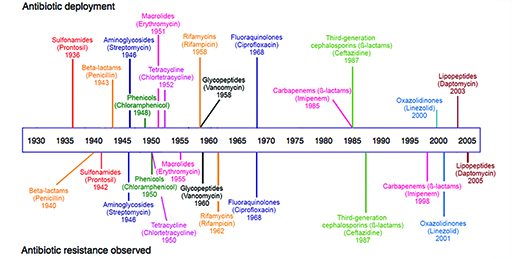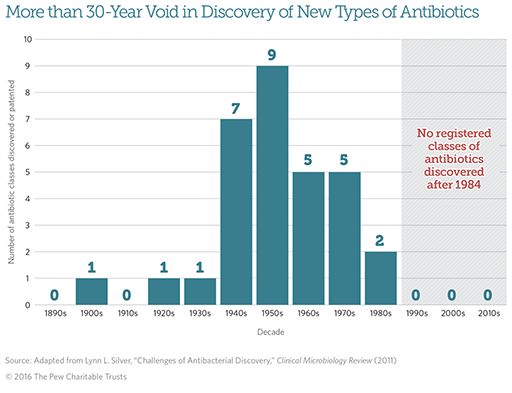3 Current status of antibiotics
The heyday of antibiotics was from the 1940s to the 1960s and 1970s. This was a time when new antibiotic classes were identified and approved for clinical use, and antibiotic resistance was under control.
Since then, the stock of antibiotics able to cure bacterial infections has been seriously depleted. Antibiotic resistance has soared and the development of new drugs has not kept pace with the need to replace those which no longer work (Figure 4).
In recent years, two potential new classes of antibiotic have been discovered from soil bacteria: teixobactin in 2015 (Ling at al., 2015) and the malacidins in 2018 (Hover, 2018).
In the next activity, you will explore how quickly bacteria develop resistance to newly introduced antibiotics.
Activity 2 Antibiotic activity and resistance timeline
Review Figure 5 and then answer the questions below.

- Which antibiotic class had the longest interval between its introduction and resistance appearing?
- What can you say in general about how long it takes resistance to develop once an antibiotic is brought into clinical use?
- In some cases, such as penicilin, resistance to the antibiotic is observed before use of the drug becomes widespread. Why is this?
Answer
- It took 13 years before resistance to imipenem, the first carbapenem, to be observed.
- Resistance can develop quickly once an antibiotic becomes widely used. In most cases, resistance develops within two years of the antibiotic being introduced.
- As you learned in Week 3, bacteria may have an intrinsic resistance to an antibiotic. It is not too surprising then that resistant bacteria are observed during the period between the initial discovery of an antibiotic and the point at which it is approved for clinical use.
Research and development into new drugs is an essential component of strategies to tackle the antibiotic resistance crisis. Unfortunately, as you will see in Section 4, this is not straightforward.

